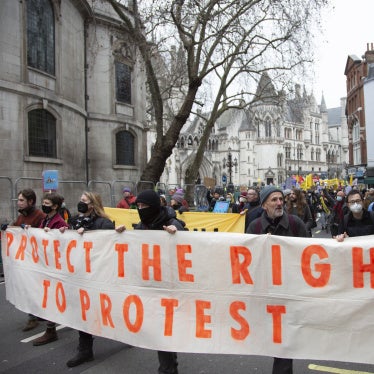June 21, 2018
The government and parliament of the Republic of Serbia
RE: Human Rights Watch submission to the draft Law on amendments and additions to the Law on Registry Books, art.25 adding a new art. 45b on gender recognition issues
Human Rights Watch is an independent international human rights organization working to defend the human rights of people worldwide. We monitor and report on human rights violations in some 90 countries around the world.
Human Rights Watch welcomes the opportunity to offer our submission to the government and parliament of the Republic of Serbia regarding the draft Law on amendments and additions to the Law on Registry Books, art. 25 adding a new art. 45b. This article deals with the procedure for gender recognition.
Human Rights Watch urges the government and parliament of the Republic of Serbia to adopt a self-declaration model, which allows change of gender identity by means of the applicant submitting a specific declaration self-identifying in a particular gender without any medical intervention requirements, personal status restrictions or any procedural complexity.
Right to Recognition Before the Law
The right to recognition as a person before the law is guaranteed in numerous international human rights instruments and is a fundamental aspect of affirming the dignity and worth of each person.
Recognition before the law is articulated in the Universal Declaration of Human Rights and guaranteed in the International Covenant on Civil and Political Rights (ICCPR) and the Convention on the Rights of the Child.[1] The right to preserve
one’s identity is guaranteed by article 8 of the Convention on the Rights of the Child, which specifies three aspects of identity— nationality, name, and family relations—but that list is not exhaustive. Together with the right to protection from arbitrary interference in privacy, such as found in article 17 of the ICCPR, the right to preserve one’s identity extends to the way one’s identity is reflected on state-issued documents.
International standards and best practices call for separation of legal and medical processes of gender reassignment for transgender people. Domestic lawmakers and tribunals are increasingly reflecting these standards in legislation and court judgments.
In 2013, the United Nations Special Rapporteur on Torture noted that: “In many countries transgender persons are required to undergo often unwanted sterilization surgeries as a prerequisite to enjoy legal recognition of their preferred gender.”[2] The Special Rapporteur noted a trend of finding such compulsory sterilization a violation of human rights, including non-discrimination rights and integrity, and called upon governments to “to outlaw forced or coerced sterilization in all circumstances and provide special protection to individuals belonging to marginalized groups.”[3]
A 2012 report of the UN Office of the High Commissioner for Human Rights (OHCHR), prepared in response to a 2011 Human Rights Council resolution calling for an end to violence and discrimination on the basis of sexual orientation and gender identity and expression, noted that “[r]egulations in countries that recognize changes in gender often require, implicitly or explicitly, that applicants undergo sterilization surgery as a condition of recognition. Some States also require that those seeking legal recognition of a change in gender be unmarried, implying mandatory divorce in cases where the individual is married.”[4]
In a 2015 report, mandated by a 2014 Human Rights Council resolution on sexual orientation and gender identity, OHCHR recommended that states begin immediately “[i]ssuing legal identity documents, upon request, that reflect preferred gender, eliminating abusive preconditions, such as sterilization, forced treatment and divorce.”[5] The 2015 “Blueprint for the Provision of Comprehensive Care for Trans People in Asia and the Pacific,” co-published by World Health Organization (WHO), UN Development Program (UNDP), USAID, PEPFAR, the Asia-Pacific Transgender Network, and the Health Policy
Project recommended that governments “[t]ake all necessary legislative, administrative, and other measures to fully recognize each person’s self-defined gender identity, with no medical requirements or discrimination on any grounds.”[6]
The Yogyakarta Principles on the Application of International Human Rights Law in relation to Sexual Orientation and Gender Identity, guidelines that interpret international human rights law as it applies to sexual orientation and gender identity, state that each person’s self-defined sexual orientation and gender identity is “integral to their personality” and is a basic aspect of self-determination, dignity and freedom. They are clear that gender recognition may involve, “if freely chosen, modification of bodily appearance or function by medical, surgical or other means.”[7] Put simply, the process for legal recognition should be separate from any medical interventions. But if an individual’s personal transition process requires medical support, those services should be available and accessible.
Principle 3 of the Yogyakarta Principles states:
Everyone has the right to recognition everywhere as a person before the law. Persons of diverse sexual orientations and gender identities shall enjoy legal capacity in all aspects of life. Each person’s self-defined sexual orientation and gender identity is integral to their personality and is one of the most basic aspects of self-determination, dignity, and freedom. No one shall be forced to undergo medical procedures, including sex reassignment surgery, sterilization or hormonal therapy, as a requirement for legal recognition of their gender identity. No status, such as marriage or parenthood, may be invoked as such to prevent the legal recognition of a person’s gender identity. No one shall be subjected to pressure to conceal, suppress, or deny their sexual orientation or gender identity.[8]
In June 2013, the Parliamentary Assembly of the Council of Europe, a regional body comprised of 47 member states, including the Republic of Serbia, passed Resolution 1945, calling for an end to coercive sterilization and castration. Transgender people are listed as one of the groups in the Council of Europe countries disproportionally affected by coercive sterilization.[9]
Health Bodies Separate Medical Procedures from Legal Process
In a 2014 joint statement of UN agencies, the WHO, UN Program on HIV/AIDS (UNAIDS), OHCHR, UNDP, UNICEF, and UNFPA said: “States parties’ obligation to respect the right to health requires that they abstain from imposing discriminatory practices. This includes an obligation to respect the rights of persons with disabilities and transgender and intersex persons, who also have the right to retain their fertility.”[10] The agencies called on governments to “[p]rovide legal guarantees for full, free and informed decision-making and the elimination of forced, coercive and otherwise involuntary sterilization, and review, amend and develop laws, regulations and policies in this regard.”[11]
International health expert bodies have in recent years strengthened their positions against medical models for legal gender recognition.
The World Professional Association for Transgender Health (WPATH), an international multidisciplinary professional association aimed at promoting evidence-based care, education, research, advocacy, public policy, and respect in transgender health and comprised of over 700 members worldwide, called for removal of any sterilization requirements as part of legal gender recognition in a 2010 statement.[12]
WPATH stated:
No person should have to undergo surgery or accept sterilization as a condition of identity recognition. If a sex marker is required on an identity document, that marker could recognize the person’s lived gender, regardless of reproductive capacity. The WPATH Board of Directors urges governments and other authoritative bodies to move to eliminate requirements for identity recognition that require surgical procedures.[13]
In 2015 WPATH updated the statement, reiterating its condemnation of forced sterilization, and expanding its critique of arduous and medicalized procedures for legal gender recognition, saying: “No particular medical, surgical, or mental health treatment or diagnosis is an adequate marker for anyone’s gender identity, so these should not be requirements for legal gender change” and “Marital status and parental status should not affect legal recognition of gender change, and appropriate legal gender recognition should be available to transgender youth.”[14]
Mental health bodies have also evolved their standards in recent years. Both the International Classification of Diseases (ICD), which is published by the UN World Health Organization, and the Diagnostic and Statistical Manual (DSM), which is published by the American Psychiatric Association (APA). The DSM has eliminated the diagnosis of “Gender Identity Disorder” (GID), and the ICD’s draft version for an upcoming revision proposes removing GID as well.
In 2012 the APA’s board’s changes to the latest DSM removed the term “Gender Identity Disorder.” The APA instead added the term “Gender Dysphoria” with the specific definition that it refers to emotional distress over “a marked incongruence between one’s experienced/expressed gender and assigned gender.” The APA specifically clarified:
It is important to note that gender nonconformity is not in itself a mental disorder. The critical element of gender dysphoria is the presence of clinically significant distress associated with the condition.[15]
The WHO is currently revising the ICD. In the latest draft, which was published this month, the global standards no longer contain a diagnostic category for “Gender Identity Disorder” and all diagnostic codes related to experiences of transgender people appear in a sexual health chapter, not the current mental disorders chapter.[16]
Global Changes to Domestic Laws
Countries around the world have begun to apply these standards. Sweden, the Netherlands, Malta, Denmark, and Ireland recently changed their legal recognition procedures to remove invasive medical requirements, and Denmark and Malta, along with Argentina, also do not require a medical diagnosis for legal gender recognition.[17] For example, in Argentina, anyone over the age of 18 can choose their gender identity, undergo gender reassignment, and revise official documents without any prior judicial or medical approval, and children can do so with the consent of their legal representatives or through summary proceedings before a judge.
As the Special Rapporteur on Torture noted in his 2013 report, national courts have begun to reflect these standards in their decisions. The special rapporteur’s report refers to numerous domestic cases, including the following:
- In 2009, the Austrian Administrative High Court ruled that mandatory gender reassignment, as a condition for legal recognition of gender identity, was unlawful.[18]
- In 2011, the Constitutional Court in Germany found that the requirement of gender reassignment surgery violated the rights to physical integrity and self-determination.[19]
- In 2012, the Swedish Administrative Court of Appeals ruled that forced sterilization could not be seen as voluntary.[20]
- In September 2014 the Norwegian Equality Body ruled that the Ministry of Health had provided no justification for the sterilization requirement in its gender recognition law, and thus the sterilization requirement was deemed to contravene the Anti-Discrimination Act.[21]
While the specific outcomes of policy changes have differed—in some cases, allowing for individuals to change documents from “male” to “female” and in others allowing for change to a third gender category, the underpinnings of the arguments are similar: self-identification, and the non-interference of medical or other authorities in the process. Courts in Asia have demonstrated this commitment to medical non-interference in legal gender recognition processes, including in the following cases:
- In a 2007 judgment, the Nepal Supreme Court’s definition of a third gender category situated it as a minority encompassing a broad range of identities for transgender and gender non-conforming people.[22] A 2014 study found that respondents wrote in 16 different terms for their gender identities.[23] The court made clear that the sole criterion for being legally recognized as third gender on documents and in government registers was an individual’s “self-feeling.”[24] The judgment cited the right to recognition before the law, guaranteed by article 16 of the ICCPR, as well as the Yogyakarta Principles.
- In 2013, India’s Supreme Court stated that undertaking medical procedures should not be a requirement for legal recognition of gender identity. The court said: “Few persons undertake surgical and other procedures to alter their bodies and physical appearance to acquire gender characteristics of the sex which conform to their perception of gender, leading to legal and social complications since official record of their gender at birth is found to be at variance with the assumed gender identity.” And continued: “Gender identity, therefore, refers to an individual’s self-identification as a man, woman, transgender or other identified category.” The court made it clear that mandatory sterilization was not acceptable: “no one shall be forced to undergo medical procedures, including SRS, sterilization or hormonal therapy, as a requirement for legal recognition of their gender identity.”[25]
- In 2015, the Delhi High Court reinforced that, “Everyone has a fundamental right to be recognized in their gender” and that “gender identity and sexual orientation are fundamental to the right of self-determination, dignity and freedom.”[26]
Conclusion
The law should not force people to carry an identity marker that does not reflect who they are. Recognizing, in law, peoples’ self-identified gender is not asking governments to acknowledge any new or special rights; instead, it is a commitment to the core idea that the state or other actors will not decide for people who they are.
The government of the Republic of Serbia, in line with its international human rights obligations and regional and global trends, should develop a legal gender recognition procedure that is accessible, transparent, and protects the dignity and privacy of those people who wish to have their gender identity reflected on official documents. The administrative, legal procedure should be separate from all medical interventions and processes, and affirmative health care should be available to those who want it.
[1] Universal Declaration of Human Rights, art. 6, G.A. Res. 217(III) A, U.N. Doc. A/RES/217(III) (Dec. 10, 1948); see also Convention on the Rights of the Child arts. 7–8, opened for signature Nov. 20, 1989, 1577 U.N.T.S. 3 (entered into force Sept. 20, 1990); International Covenant on Civil and Political Rights art. 16, opened for signature Dec. 19, 1966, 999 U.N.T.S. 171 (entered into force Mar. 23, 1976).
[2] Report of the Special Rapporteur on Torture, UN Doc. A/HRC/22/53, para. 78.
[3] Ibid., para. 88.
[4] Human Rights Council, Discriminatory Laws and Practices and Acts of Violence against Individuals Based on Their Sexual Orientation and Gender Identity: Report of the United Nations High Commissioner for Human Rights, UN Doc. A/HRC/19/41 (November 17, 2011), para. 72.
[5] Human Rights Council, Discrimination and Violence against Individuals Based on Their Sexual Orientation and Gender Identity: Report of the Office of the United Nations High Commissioner for Human Rights, UN Doc. A/HRC/29/23 (May 4, 2015), para. 79(i).
[6] Health Policy Project, Asia Pacific Transgender Network, United Nations Development Programme, Blueprint for the Provision of Comprehensive Care for Trans People and Trans Communities in Asia and the Pacific (Washington, DC: Futures Group, Health Policy Project, 2015), p. 112, http://www.healthpolicyproject.com/pubs/484_APTBFINAL.pdf (accessed January 12, 2016).
[7] Yogyakarta Principles on the Application of International Human Rights Law in relation to Sexual Orientation and Gender Identity, http://www.yogyakartaprinciples.org/principles_en_principles.htm.
[8] Ibid. principle 3.
[9] Parliamentary Assembly of the Council of Europe, Resolution 1945 (2013), June 2013. http://assembly.coe.int/ASP/Doc/XrefViewPDF.asp?FileID=19984&Language=EN.
[10] OHCHR et al., Eliminating Forced, Coercive and Otherwise Involuntary Sterilization, p. 10.
[11] Ibid., p. 13.
[12] WPATH statement (June 10, 2010), http://www.wpath.org/uploaded_files/140/files/Identity%20Recognition%20Statement%206-6-10%20on%20letterhead.pdf
[13] WPATH statement (June 10, 2010).
[14] WPATH statement on Legal Gender Recognition, 2015. http://www.wpath.org/uploaded_files/140/files/WPATH%20Statement%20on%20Legal%20Recognition%20of%20Gender%20Identity%201-19-15.pdf (accessed January 12, 2016).
[15] The American Psychiatric Association. Gender Dysphoria Fact Sheet, 2012. http://www.dsm5.org/documents/gender%20dysphoria%20fact%20sheet.pdf
[16] World Health Organization ICD-beta: http://apps.who.int/classifications/icd11/browse/l-m/en
[17] For Denmark, see Motion to Law amending the Law on the Central Office (Assigning new personal number for people who experience themselves as belonging to the other sex). Available online at: http://www.ft.dk/RIpdf/samling/20131/lovforslag/L182/20131_L182_som_fremsat.pdf; and for Malta see: Gender Identity, Gender Expression and Sex Characteristics Act, 2015. http://justiceservices.gov.mt/DownloadDocument.aspx?app=lp&itemid=26805&l=1 (accessed January 12, 2016). For Argentina: IDENTIDAD DE GENERO Ley 26.743 Establécese el derecho a la identidad de género de las personas. Available online at: http://tgeu.org/argentina-gender-identity-law/.
[18] Austrian Administrative Court Cases (VwGH) 2008/17/0054 (decided on 27 January 2009); Austrian Constitutional Court (VfGH) Case B 1973/08-13 (decided on 3 December 2009). Cited in Transgender Europe (2013).
[19] Federal Constitutional Court of Germany, 1 BvR 3295/07, 28.01.2011. Available online at: http://www.icj.org/sogicasebook/1-bvr-3295-07-federal-constitutional-court-germany-11-january-2011/.
[20] Mål nr 1968-12, Kammarrätten i Stockholm, Avdelning 03, 19 December 2012. Available online at: http://tgeu.org/administrative-court-ofappeal-in-stockholm-on-sterilisation-requirement-in-gender-recognitionlegislation-19-dec-2012/.
[21] Transgender Europe, Norwegian Ombud decides forced sterilisation is discrimination, September 13, 2013, available on line at: http://tgeu. org/tgeu-statement-norwegian-ombud-decides-forced-sterilisation-isdiscrimination/.
[22] Michael Bochenek and Kyle Knight, “Establishing a Third Gender Category in Nepal: Process and Prognosis,” Emory International Law Review, Vol. 26, Issue 1, 2012: http://law.emory.edu/eilr/_documents/volumes/26/1/recent-developments/bochenek-knight.pdf (accessed January 12, 2016).
[23] Kyle Knight, Andrew Flores, and Sheila Nezhad, “Surveying Nepal’s Third Gender,” Transgender Studies Quarterly, Vol 2. No. 2, 2015; The Williams Institute, “Surveying Nepal’s Sexual and Gender Minorities: An Inclusive Approach,” October 2014: http://williamsinstitute.law.ucla.edu/research/international/surveying-nepals-sexual-and-gender-minorities/ (accessed January 12, 2016).
[24] Pant v. Nepal, Writ No. 917 of the Year 2064 BS (2007 AD), translated in NAT’L JUD. ACAD. L.J.,
[25] National Legal Services Center v. Union of India and Others. WRIT PETITION (CIVIL) NO.400 OF 2012, http://www.lawyerscollective.org/wp-content/uploads/2014/04/Transgender-judgment.pdf (accessed January 12, 2016).
[26] Bhat v. State of NCT of Delhi and Others. W.P.(CRL) 2133/2015, http://lobis.nic.in/ddir/dhc/SID/judgement/05-10-2015/SID05102015CRLW21332015.pdf (accessed January 12, 2016).







